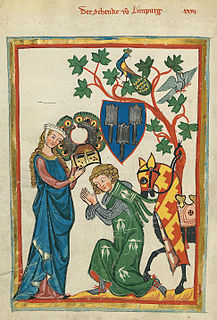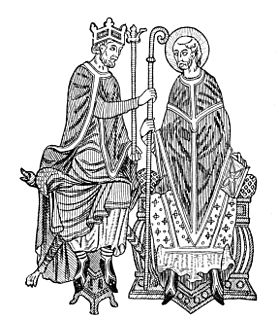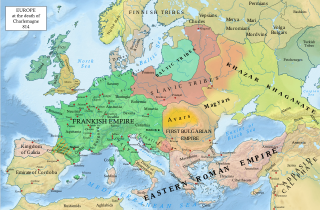
Christendom has several meanings. In one contemporary sense, as used in a secular or Protestant context, it may refer to the "Christian world": Christian-majority countries and the countries in which Christianity dominates or prevails, or, in the historic, Catholic sense of the word, the nations in which Catholic Christianity is the established religion, having a Catholic Christian polity.

Feudalism was a combination of legal and military customs in medieval Europe that flourished between the 9th and 15th centuries. Broadly defined, it was a way of structuring society around relationships derived from the holding of land in exchange for service or labour. Although derived from the Latin word feodum or feudum (fief), then in use, the term feudalism and the system it describes were not conceived of as a formal political system by the people living in the Middle Ages. In its classic definition, by François-Louis Ganshof (1944), feudalism describes a set of reciprocal legal and military obligations among the warrior nobility revolving around the three key concepts of lords, vassals and fiefs.

In the history of Europe, the Middle Ages lasted from the 5th to the 15th century. It began with the fall of the Western Roman Empire and merged into the Renaissance and the Age of Discovery. The Middle Ages is the middle period of the three traditional divisions of Western history: classical antiquity, the medieval period, and the modern period. The medieval period is itself subdivided into the Early, High, and Late Middle Ages.

Chivalry, or the chivalric code, is an informal, varying code of conduct developed between 1170 and 1220, but never decided on or summarized in a single document. It was associated with the medieval Christian institution of knighthood; knights' and gentlewomen's behaviours were governed by chivalrous social codes. The ideals of chivalry were popularized in medieval literature, especially the Matter of Britain and Matter of France, the former based on Geoffrey of Monmouth's Historia Regum Britanniae, written in the 1130s, which introduced the legend of King Arthur. All of these were taken as historically accurate until the beginnings of modern scholarship in the 19th century.

Burgrave also rendered as Burggrave, was since the medieval period in Europe the official title for the ruler of a castle, especially a royal or episcopal castle, and its territory called a Burgraviate or Burgravate. The burgrave was a "count" in rank equipped with judicial powers, under the direct authority of the Emperor or King, or of a territorial imperial state—a prince-bishop or territorial lord. The responsibilities were administrative, military and jurisdictional. A burgrave, who ruled over a substantially large territory, may also have possessed the regality of coinage, and could mint their own regional coins.

The Investiture Controversy or Investiture Contest was a conflict between church and state in medieval Europe over the ability to appoint local church officials through investiture. By undercutting imperial power, the controversy led to nearly 50 years of civil war in Germany. According to historian Norman Cantor, the investiture controversy was "the turning-point in medieval civilization", marking the end of the Early Middle Ages with the Germanic peoples' "final and decisive" acceptance of Christianity. More importantly, it set the stage for the religious and political system of the High Middle Ages.

The Principality of Achaea or of the Morea was one of the three vassal states of the Latin Empire which replaced the Byzantine Empire after the capture of Constantinople during the Fourth Crusade. It became a vassal of the Kingdom of Thessalonica, along with the Duchy of Athens, until Thessalonica was captured by Theodore, the despot of Epirus, in 1224. After this, Achaea became for a while the dominant power in Greece.

An Imperial State or Imperial Estate was a part of the Holy Roman Empire with representation and the right to vote in the Imperial Diet. Rulers of these Estates were able to exercise significant rights and privileges and were "immediate", meaning that the only authority above them was the Holy Roman Emperor. They were thus able to rule their territories with a considerable degree of autonomy.
Examples of feudalism are helpful to fully understand feudalism and feudal society. Feudalism was practiced in many different ways, depending on location and time period, thus a high-level encompassing conceptual definition does not always provide a reader with the intimate understanding that detailed historical examples provide.

In medieval and early modern Europe the term tenant-in-chief, denoted a person who held his lands under various forms of feudal land tenure directly from the king or territorial prince to whom he did homage, as opposed to holding them from another nobleman or senior member of the clergy. The tenure was one which denoted great honour, but also carried heavy responsibilities as the tenants-in-chief were originally responsible for providing knights and soldiers for the king's feudal army.

German mediatisation was the major territorial restructuring that took place between 1802 and 1814 in Germany and the surrounding region by means of the mass mediatisation and secularisation of a large number of Imperial Estates. Most ecclesiastical principalities, free imperial cities, secular principalities, and other minor self-ruling entities of the Holy Roman Empire lost their independent status and were absorbed into the remaining states. By the end of the mediatisation process, the number of German states had been reduced from almost 300 to just 39.
A vestry was a committee for the local secular and ecclesiastical government for a parish in England and Wales, which originally met in the vestry or sacristy of the parish church, and consequently became known colloquially as the "vestry".

Prince of the Holy Roman Empire was a title attributed to a hereditary ruler, nobleman or prelate recognised as such by the Holy Roman Emperor.

The Sachsenspiegel is the most important law book and custumal of the Holy Roman Empire. Originating between 1220 and 1235 as a record of existing customary law, it was used in places until as late as 1900. It is important not only for its lasting effect on later German law but also as an early example of written prose in a German language. The Sachsenspiegel is the first comprehensive law book not in Latin, but in Middle Low German language. A Latin edition is known to have existed, but only fragmented chapters remain.

Ecclesiastical heraldry refers to the use of heraldry within the Christian Church for dioceses and Christian clergy. Initially used to mark documents, ecclesiastical heraldry evolved as a system for identifying people and dioceses. It is most formalized within the Catholic Church, where most bishops, including the Pope, have a personal coat of arms. Clergy in Anglican, Lutheran, Eastern Catholic and Eastern Orthodox churches follow similar customs, as do institutions such as schools and dioceses.

Eike of Repgow was a medieval German administrator who compiled the Sachsenspiegel code of law in the 13th century.

German heraldry is the tradition and style of heraldic achievements in Germany and the Holy Roman Empire, including national and civic arms, noble and burgher arms, ecclesiastical heraldry, heraldic displays and heraldic descriptions. German heraldic style is one of the four major broad traditions within European heraldry and stands in contrast to Gallo-British, Latin and Eastern heraldry, and strongly influenced the styles and customs of heraldry in the Nordic countries, which developed comparatively late. Together, German and Nordic heraldry are often referred to as German-Nordic heraldry.
Johannes Klenkok was a German Augustinian friar, known as a theologian and disciple of Gregory of Rimini.
Feudalism in the Holy Roman Empire was a politico-economic system of relationships between liege lords and enfeoffed vassals that formed the basis of the social structure within the Holy Roman Empire during the High Middle Ages. In Germany the system is variously referred to Lehnswesen, Feudalwesen or Benefizialwesen.

















